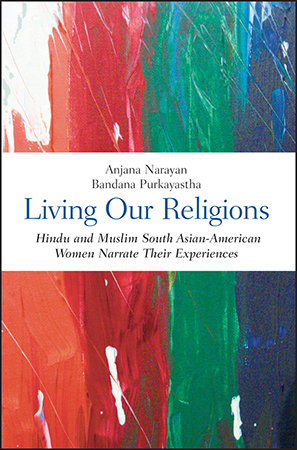Living Our Religions sheds important light on the lives of Hindu and Muslim American women of South Asian origin. As the authors reveal their diverse and culturally dynamic religious practices, describe the race, gender, and ethnic boundaries that they encounter, and document how they resist and challenge these boundaries, they cut through the myths and ethnocentrism of popular portrayals to reveal the vibrancy, courage, and agency of an "invisible" minority.
Anjana Narayan is assistant professor of sociology at California State Polytechnic University, Pomona. Bandana Purkayastha is professor of sociology and Asian American Studies at the University of Connecticut.
"A powerful 'multiple critique' of the still socially and religiously hegemonic orientalist, 'fundamentalist,' 'conventional' Western feminist ... and sensationalist mainstream mass media discourses about the place and status of women in religious traditions, in particular Hinduism and Islam."—Gender & Society
"An innovative collection of essays about religion and gender written by Hindu and Muslim women of South Asian origin living in the United States.... Most significantly, the authors provide alternative narratives to orientalist critiques of Hindu’s and Islam’s treatment of women.... An excellent resource for undergraduate courses and allows students to understand the diversity of South Asian Hinduism and Islam and the experiences of religious minorities in the United States."—Religious Studies Review
"Lucid in its narration and heartfelt in the scholars' careful etching of their religious, culturally specific and spiritual selves as a rightful, albeit negotiated part of their lives in the USA."—South Asian Diaspora
"Vivid and provocative essays captures the rich diversity of religious experience among South Asian American women. [This book] challenges popular assumptions about religion and South Asia."—Nazli Kibria, Boston University
"This collection of thought-provoking essays illuminates our understanding of the multiple contexts that shape South Asian American women’s religious experiences. Through nuanced narratives, the authors compel us to break down simplistic stereotypes about religion and South Asia and to take a fresh look at the linkages between gender and religion."—Margaret Abraham, Hofstra University
"This highly topical book is both timely and reflective of the contemporary challenges faced by many women who belong to complex networks and communities, including religious communities, and who recognize both the complexity that this relationship entails and its contribution to our universal understanding of humanity and spiritual well-being. It is an ambitious piece of work which successfully achieves its primary aim that is, to narrate the experiences of Hindu and Muslim South Asian American women based upon their personal and lived realities." —Journal of Intercultural Studies






